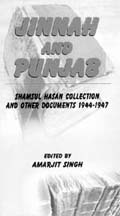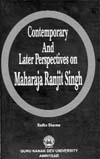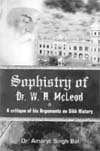|
SHORT TAKES
Jinnah & the maharaja
Randeep Wadehra
Jinnah and Punjab
Ed Amarjit Singh
Kanishka, New Delhi. Pages xlv+354. Rs 850
 It’s a known fact
that in pre-P artition Punjab it was the secular Unionist Party that had
popular support whereas the fanatical, Jinnah-led, Muslim League was
struggling to secure a toehold in the region – something it eventually
achieved thanks to British machinations. Nevertheless, Jinnah’s own
efforts too proved decisive in the League’s ascendancy, resulting in
blood-drenched Partition. This book contains a collection of the
Qaid-e-Azam’s correspondence with such leaders of Punjab Muslim League
as Nawab Iftikhar Hussain Khan, M. Rafi Butt, Abdul Hamid Iqbal, S.
Sadiq Hassan, Syed Aslam, Mumtaz Daultana etc on topics ranging from
collection of funds to strengthening of the party’s organisational
structure. References to ‘our enemies’ give us insights into his
phobias. The editor could’ve done away with fluffy social epistles,
from and to Lady Vicky Noon for example, which are bereft of any
political significance and aren’t, in any tangible manner, in
consonance with the book’s theme. It’s a known fact
that in pre-P artition Punjab it was the secular Unionist Party that had
popular support whereas the fanatical, Jinnah-led, Muslim League was
struggling to secure a toehold in the region – something it eventually
achieved thanks to British machinations. Nevertheless, Jinnah’s own
efforts too proved decisive in the League’s ascendancy, resulting in
blood-drenched Partition. This book contains a collection of the
Qaid-e-Azam’s correspondence with such leaders of Punjab Muslim League
as Nawab Iftikhar Hussain Khan, M. Rafi Butt, Abdul Hamid Iqbal, S.
Sadiq Hassan, Syed Aslam, Mumtaz Daultana etc on topics ranging from
collection of funds to strengthening of the party’s organisational
structure. References to ‘our enemies’ give us insights into his
phobias. The editor could’ve done away with fluffy social epistles,
from and to Lady Vicky Noon for example, which are bereft of any
political significance and aren’t, in any tangible manner, in
consonance with the book’s theme.
Contemporary and
later perspectives on Maharaja Ranjit Singh
by Radha Sharma
Guru Nanak Dev University, Amritsar. Pages: ix+170. Rs 200.
 Maharaja Ranjit Singh’s
persona continues to evoke academic interest. Although a devout Sikh
(his government was referred to as Sarkar-e-Khalsa) he kept the Akalis
in check and "by destroying the misls and allowing the gurmata
to decay" he transformed "the whole constitution of the Sikhs
from an irregular theocratic commonwealth of a loose federal type into
an absolute monarchical type`85" thus uniting Punjab under his rule
and extending his sway beyond the state’s frontiers. Merit and not
caste, community or creed decided employment and promotion in his
empire. This book contains writings by assorted chroniclers on the
Maharaja during his reign as well as after Punjab’s annexation,
depicting the changing scholarly perceptions in the process. Maharaja Ranjit Singh’s
persona continues to evoke academic interest. Although a devout Sikh
(his government was referred to as Sarkar-e-Khalsa) he kept the Akalis
in check and "by destroying the misls and allowing the gurmata
to decay" he transformed "the whole constitution of the Sikhs
from an irregular theocratic commonwealth of a loose federal type into
an absolute monarchical type`85" thus uniting Punjab under his rule
and extending his sway beyond the state’s frontiers. Merit and not
caste, community or creed decided employment and promotion in his
empire. This book contains writings by assorted chroniclers on the
Maharaja during his reign as well as after Punjab’s annexation,
depicting the changing scholarly perceptions in the process.
Sophistry of Dr. WH
Mcleod
by Dr. Amarjit Singh Bal.
B. Chattar Singh Jiwan Singh,
Amritsar. Pages xxii+215. Rs 250.
 Every organised religion
is a mix of history, theology and mythology; the latter two act as its
bedrock. Theology provides doctrine and principles to be adhered to by
the followers while mythology provides inspirational tales and role
models in order to keep the pious perpetually enthralled and inspired.
History shapes a community’s outlook even as it lends authenticity, no
matter how tenuously, to theological and mythological literature. But,
it’s a historian’s scientific temper that irks the faithful.
Something similar is indicated by this book’s contents. However,
readers may like to judge this for themselves. Every organised religion
is a mix of history, theology and mythology; the latter two act as its
bedrock. Theology provides doctrine and principles to be adhered to by
the followers while mythology provides inspirational tales and role
models in order to keep the pious perpetually enthralled and inspired.
History shapes a community’s outlook even as it lends authenticity, no
matter how tenuously, to theological and mythological literature. But,
it’s a historian’s scientific temper that irks the faithful.
Something similar is indicated by this book’s contents. However,
readers may like to judge this for themselves.
|